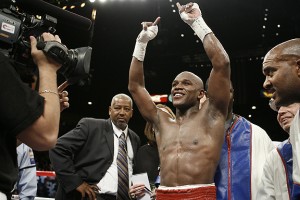
On Sept. 14 boxing fans will congregate for “The One,” a pay-per-view fight card with a main event, Floyd “Money” Mayweather versus Saul “Canelo” Alvarez, and a co-main event, Lucas Matthysse versus Danny Garcia. Since that questionable prefix “co” was put there by someone else, and since any aficionado can tell you Matthysse-Garcia is much the more interesting fight, what do you say we save its preview for next week and treat Sept. 14’s other main event now?
There is a temptation whenever one watches Floyd Mayweather on a program he credits himself with executively producing to fixate on the banality of the spectacle, the vapidity of a guy telling you autobiographical details for the 17th time that were boring the first time, 6 1/2 years ago. But such fixation is missing the point if one wishes to understand the spectacle, forgiving, as always, any adult understandably uninterested in understanding the spectacle.
The purpose of the spectacle, and this Mayweather well comprehends, is saturation, a process television does better than its predecessor mediums, a means not unlike what immersion serious foreign-language students subject themselves to, a way of surrounding a person’s associations, and therefore thoughts, with an idea that goes to the very root of what makes a mind human: Sociability. A desire to socialize is what helped our ancestors climb out the trees in which they were cowering from all predators larger and faster and stronger, which were most, and develop an unprecedented form of communication that took them, in record time, to a place of predatory dominance so far beyond their adversaries they locked up the descendants of the creatures that feasted on them, in zoos, for their children’s amusement.
A biological drive to be round others and communicate with them, connecting in some necessary way, is the trait television preys on, flashing images that say nothing so profoundly as: “This is important because everyone is watching it because it is important enough for everyone to watch.” It’s an algorithm even a kindergartner can untwine, doing something because you are doing it, and it works and works so long as television can find its way to your retina, a gambit the ongoing unpleasantness between Time Warner Cable and CBS now cancels.
But wait, Showtime’s got round Time Warner Cable by posting its wholly unoriginal “All Access” program on the internet! Yes, well, that is helping it reach exactly zero new pay-per-viewers, because if you cared enough about “All Access: Mayweather vs. Canelo” to search for it online, your purchase of their Sept. 14 show is already accounted for; you are the 300,000th buyer, not the millionth. Which leaves the promotion with Canelomania in Mexico, real a phenomenon as anything built on television but doubtfully enough to set what records “The One’s” press tour assured.
Canelomania is evidence of television’s power in a way not even Mayweather quite understands; Alvarez is marketed continually, and has been for years, by Grupo Televisa, a media outfit whose affiliates own more than half the television stations in Mexico – for an American to understand Televisa’s power, he’d have to go back to the pre-cable days of three channels in the United States, and then combine a couple. The Televisa script says Alvarez is a midnight-clad villain but an innocent-faced hero, a fireheaded anomaly but an everyman, a taciturn corrupter of other men’s flesh but a caresser of baby’s cheeks, an urbane fashionista but a tamer of beach steeds, a man who dines in a silver microfiber suit and bathes in a ballbearing black bikini bottom – like an OkCupid profile unrestrained by plausibility. He has dated a Televisa reporter, dated Miss Mexico for Televisa, and visited on Televisa with Mexican president Enrique Peña Nieto, the husband of a Televisa actress.
Canelo Alvarez is the Mexican rendition of contemporary American marketing’s best invention: An otherwise unmarked canvas with a unique imprimatura layer – Tiger Woods in 1998, Barack Obama in 2004 – onto which young and old alike can project their own best qualities. Earl Woods, an all-American dad in the very worst sense of those words, helped market his son as a savior; before America’s leader was President Obama he was derisively called “The One” by Republican campaign operatives; and in two Saturdays Saul Alvarez fights in “The One,” a singular event that will either mark Alvarez as boxing’s savior (Mayweather sure wasn’t) or, much more likely, mark him as yet another “one” some country or ethnicity got hoodwinked into projecting its collective pride on for what 36 minutes it took Floyd Mayweather to unknit him.
Is this fight unwatchably predictable as Mayweather’s last? No, decidedly it is not; Alvarez is a legitimately larger prizefighter who throws his right cross early, like one who knows no better, and Mayweather is a man who, Shane Mosley avers, can be caught with a righthand during the five minutes it takes him to secure escape routes and seal an opponent’s every exit. If Alvarez somehow buckles Mayweather the way Mosley did, Money May will have pounced on him a creature sourly distinct from the Sugar Shane he got 40 months ago.
But if the bell rings to begin round 3 and Alvarez has yet to imperil Mayweather, well, you’ll still have the co-main for solace, but not suspense: In his lifetime of fighting both amateurs and professionals, Mayweather has seen everything about Canelo, save his fabulous redbrick hair, at least 50 times, while Canelo has seen the likes of Mayweather not once. Plan accordingly.
Bart Barry can be reached at bart.barrys.email (at) gmail.com